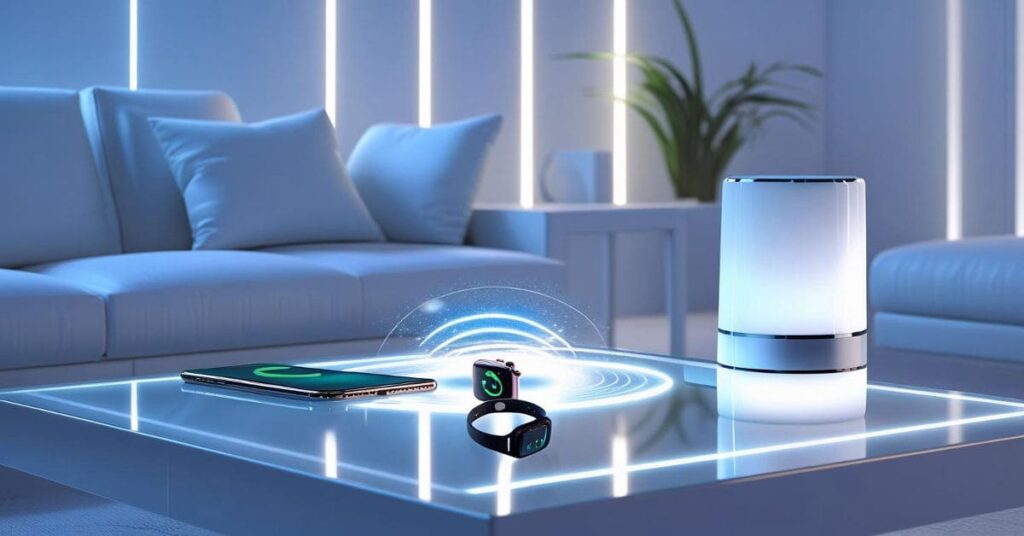Introduction
Consider arriving at your home with your devices already charged and ready to use—no more tangles with wires or unplugging devices. The future welcomes RF wireless charging. Smart homes are getting transformed with RF Wireless Charging Devices like these. Apart from convenience, RF wireless charging makes powering gadgets easier and improves energy efficiency without compromising home aesthetics. Let us delve into how this cutting-edge technology, RF wireless charging, alters domestic life.
Table of Contents
Understanding RF Wireless Charging

RF wireless charging is a novel technology that is starting to attract attention in the smart home arena. Though charging devices is something that has captured most people’s attention, not as many people are aware of the details that distinguish RF (radio frequency) wireless charging from other types. RF wireless charging is enabling the move toward a future in which the act of charging devices is not only clutter-free but is deeply embedded in the very structure of the home, truly effortless. Before we explain the benefits of RF wireless charging, let us take a closer look at the technology behind this groundbreaking development.
The Technology Behind RF Wireless Charging
The RF wireless charging system employs radio signals to deliver power to the device. In a way, this is akin to magic, albeit rooted in deeply sophisticated technological principles. RF wireless charging uses an RF transmitter that converts electrical energy to radio signals, sending them to the RF receiver, which captures the signals. The radio waves undergo an event process and a transformation process to be converted into usable electrical energy.
The uniqueness of RF wireless charging stems from the fact that there is no direct line of sight or contact necessary between the transmitter and the receiver. Devices that are within the range of RF transmitters can be charged. Imagine a smart home where smart devices such as mobile phones, AI assistants, and others could charge themselves automatically. That is the wonder of automation.
Key Benefits of RF Wireless Charging in Smart Homes
Adopting RF wireless charging provides a unique set of advantages that transform the way we engage with technology in the home:
- No Tangled Wires or Clutter: Enjoy the convenience of a neat and organized space. No longer will you have to dig through a jumbled mess of charging cables because with RF wireless charging, all devices will be charged efficiently without the need for cables.
- Automatic Device Charging: Never have to think about charging devices again. As soon as a device enters the coverage area, RF charging will kick in and charge devices seamlessly, ensuring they are always powered.
- Versatile Device Usage: The freedom for devices to move without being tethered to a charging pad greatly enhances device mobility. Unlike traditional wireless charging, RF charging provides the ability to move freely within the charging field, increasing productivity with minimal effort.
- Integration with Smart Homes: RF technology seamlessly integrates with other home automation systems like lighting and security, embodying the vision of a future that is fully interconnected and intelligent.
Comparison with Traditional Charging Methods
Compared to other techniques of charging electronic devices, RF wireless charging has unique advantages:
- Distance Range: RF charging excels at providing power over distance.
- Safety and Convenience: Full absence of power lines eliminates all electricity hazards, ensuring absolute safety.
- Effectiveness, Flexibility, and Lessened Restrictions: Placed upon direct placement bias to contemporaneous charging.
The advancement of smart homes marks the increased availability of RF wireless charging, indicating a shift toward greater effectiveness and convenience. This, however, raises the critical question of its practical relevance in smart homes.
Applications of RF Wireless Charging in Smart Homes

The potential for RF Wireless Charging Devices to augment various aspects of our homes is limitless.Exploring particular use cases reveals how this advanced innovation will integrate into the smart homes of the future.
Seamless Integration with Home Automation Systems
The implementation of RF wireless charging technologies transforms existing home automation systems. Visualize a modern home where illumination, alerts, temperature regulation, and even window curtains are integrated and work together. Automation systems could be more effective, and RF wireless charging technologies ensure uninterrupted power.
- Intelligent Lighting Systems: Smart wireless LED and light bulbs integrated with automation systems can be RF wireless charged, and thus, work perpetually with zero operational expenditure.
- Voice Assistants and AI: Smart home assistants such as Google Home and Alexa require a constant power source. With RF wireless charging, these devices will be actively listening and ready to assist continuously.
Powering Smart Home Gadgets and Appliances
RF wireless charging technology caters to a wide range of items, from everyday devices to complex gadgets:
- Wearable Devices: Smart devices, including smartwatches and fitness trackers, ensure automatic charging as you navigate within your home and thus, are always ready to be worn.
- Security Cameras: Chargeable battery-operated security systems need to be regularly charged, which can disrupt surveillance. RF charging ensures these devices can securely monitor and remain operational uninterrupted.
- Kitchen Gadgets: Digital kitchen devices, such as innovative coffee makers, programmable robotic vacuums, and even digital scales, can be bright and always ready to serve in a fully automated home.
Enhancing Energy Efficiency and Conservation
With the ongoing global focus on energy efficiency, RF wireless charging presents yet another clean technology alternative for energizing smart homes.
- Reduction in Energy Wastage: RF wireless charging streams smart devices and delivers energy only when needed. This curbs unnecessary energy expenditure from over-the-air power delivery.
- Smart Energy Control: Smart energy management tools for homes encompass systems that use RF technology. It also allows homeowners to monitor and manage energy expenditure from remote locations, thus ensuring effective energy conservation.
- Environmentally Friendly: RF technology decreases electronic waste in smart homes by reducing cluttered cables and the need for frequent device replacements.
With RF wireless charging, the effortless powering of devices and intelligent energy control transform the power and charge needs of devices in smart homes. Attaining the dream of energy-efficient and sustainable smart homes is significantly easier. The integration of RF wireless charging could provide the key to brilliant and interconnected homes.
Future of RF Wireless Charging in Smart Homes

The future potential of RF wireless charging in smart homes is more than just sci-fi—it is becoming a reality. Envision a household where your gadgets charge automatically in their designated places. From smartphones and tablets to larger gadgets like laptops and kitchen devices, RF wireless charging brings us closer to this reality. Now, let us explore the prospects of RF wireless charging, the challenges it might encounter, and how it can transform our perspective on energy consumption in the household.
Innovations and Advancements on the Horizon
The possibilities offered by IEEE wireless charging technologies are practically endless, considering they possess the capability to supercharge devices with energy and are a surefire game-changer in the domain of smart tech charging. Among the other endeavors being made in this field, multi-device wireless charging stands out the most, and focuses on mobile phones, tablets, laptops, and even smart wearable devices. Efficient use cases are being constructed to tackle the issue of low RF charging sensitivity in devices, which may one day ensure coverage on all devices present at home.
- Hi-Performance RF Charge: Currently, RF charging does not function significantly far from the user, but in the future, smart homes may be incorporated with devices supporting a complete RF energy charge system that can be accessed from anywhere in the house. Moreover, RF charging in its current state does not compete with other technologies that allow household power access, which are merged with Wi-Fi.
- Changing Sets of Limits: As time goes on, it is highly likely that these charging systems would be adaptive to the user and can be set to custom energy limits. Picture a scenario where charging phones are programmed only to activate when the battery is running out, allowing the user to power their phone with energy.
- Integration with Smart Home Systems: Equally interesting is the incorporation of RF charging into modern smart home systems, which enables them to communicate with each other and manage energy consumption more efficiently. While smart home devices communicate with one another on energy consumption, RF charging can give precisely what is needed.
Potential Challenges and Considerations
The outlook looks promising, but before RF wireless charging technologies can be widely accepted, several hurdles must be addressed.
- Efficiency Concerns: As with most wireless technologies, RF charging is less efficient when compared to traditional charging methods. Widespread adoption is hindered by energy loss and conversion efficiency. In most cases, balancing ease of use with efficiency is a must to avoid wasting energy.
- Compatibility and Standards: In the RF charging ecosystem, the lack of a unified standard means device interoperability is low, which is a problem. Adoption of a universal standard is crucial to avoid fragmentation in the device ecosystem, similar to the one that has battered the smartphone charging market.
- Health and Safety: Any new technology comes with its own set of concerns, and with RF, the unresolved questions of its long-term impact on human health are a core issue that needs to be addressed.
Impact on Sustainable Living and Energy Usage
Shifting to RF wireless charging technologies could promote green living and transform energy use patterns within smart homes.
- Mitigated Energy Wasting: RF charging technology’s selective use of power should eliminate energy-wasting phantom power, which is synonymous with conventional charging systems. This can significantly reduce overall energy consumption, making homes ‘smart’ and ‘green’ at the same time.
- Adoption of Clean Energy: With RF charging, homes can utilize energy from solar or wind power. Picture a home with solar panels operating appliances charged through RF, creating a renewable energy loop powered by clean energy.
- Responsible Energy Empowerment: The use of `smart’ RF charging at home may encourage homeowners to track their energy use, making them more responsible. A smart grid could track consumption and offer insights to help reduce energy use and promote positive energy changes among the users.
Smart homes equipped with RF wireless charging technology come with many excellent prospects, and with further refinement, the advantages that come with them are huge. If persistent challenges are solved, RF wireless charging technology stands poised to change the way we power devices, further enhancing the efficiency of smart homes. Looking forward, it is apparent that RF wireless charging technology not only promises ease of use, but also the opportunity to work towards a greener smart home.
Conclusion
From smart home gadgets to clever home automation systems, RF Wireless Charging Devices are revolutionizing the way smart home devices operate. With the capability to power numerous devices simultaneously without the mess of wires, our living environments are becoming more orderly and streamlined. For lovers of smart home technology, this development is especially enticing as it streamlines daily tasks, saves time, and provides effortless energy-saving options.
Smart homes are one step closer to being fully multifunctional and interconnected.
FAQs
Is wireless charging RF?
No, standard wireless charging, similar as Qi, does not utilize RF technology, as it mainly depends on inductive or reverberative inductive coupling. Meanwhile, RF or Radio Frequency charging takes a different approach by delivering power through radio frequencies over a longer range.
What is the distance for RF charging?
One of the pioneers of RF charging, Energous WattUp, operates within a range of 1-2 meters. While it does have a range limitation, its distance functionality poses constraints to charging effectiveness. Furthermore, its lack of widespread commercialization indicates that it is still in the early stages of development.
What are the three types of wireless charging?
a. Inductive (Qi): Direct contact charging using electromagnetic coils (charging pads).
b. Resonant: Mid-range (up to 10 cm) charging using resonant magnetic fields.
c. RF (Radio Frequency): Charging over longer distances (1m+) using radio waves.
What is the difference between RF and wireless?
• Wireless Charging: Usually refers to inductive/resonant methods (Qi standard) requiring proximity within 0-10 cm.
• RF Charging: Utilizes radio waves for longer-range transmission (1m+) of power; however, efficiency remains a challenge in its experimental stage.
Discover more from Snap Charge Hub
Subscribe to get the latest posts sent to your email.
